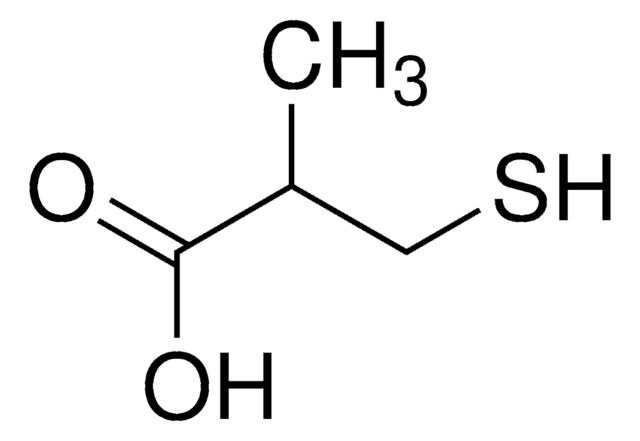63768
3-Mercaptopropionsäure
≥99.0% (HPLC)
Synonym(e):
3-MPA, 3-Sulfanylpropanoic acid, beta-Mercaptopropionic acid
About This Item
Empfohlene Produkte
Dampfdruck
0.04 mmHg ( 20 °C)
Assay
≥99.0% (HPLC)
Form
liquid
Selbstzündungstemp.
662 °F
Brechungsindex
n20/D 1.492 (lit.)
n20/D 1.493
bp
110-111 °C/15 mmHg (lit.)
mp (Schmelzpunkt)
15-18 °C (lit.)
Dichte
1.218 g/mL at 25 °C (lit.)
Absorption
cut-off at 270 nm
SMILES String
OC(=O)CCS
InChI
1S/C3H6O2S/c4-3(5)1-2-6/h6H,1-2H2,(H,4,5)
InChIKey
DKIDEFUBRARXTE-UHFFFAOYSA-N
Suchen Sie nach ähnlichen Produkten? Aufrufen Leitfaden zum Produktvergleich
Anwendung
Sonstige Hinweise
Signalwort
Danger
H-Sätze
Gefahreneinstufungen
Acute Tox. 3 Oral - Acute Tox. 4 Inhalation - Eye Dam. 1 - Met. Corr. 1 - Skin Corr. 1B
Lagerklassenschlüssel
6.1A - Combustible acute toxic Cat. 1 and 2 / very toxic hazardous materials
WGK
WGK 1
Flammpunkt (°F)
200.1 °F - closed cup
Flammpunkt (°C)
93.4 °C - closed cup
Persönliche Schutzausrüstung
Faceshields, Gloves, Goggles, type ABEK (EN14387) respirator filter
Analysenzertifikate (COA)
Suchen Sie nach Analysenzertifikate (COA), indem Sie die Lot-/Chargennummer des Produkts eingeben. Lot- und Chargennummern sind auf dem Produktetikett hinter den Wörtern ‘Lot’ oder ‘Batch’ (Lot oder Charge) zu finden.
Besitzen Sie dieses Produkt bereits?
In der Dokumentenbibliothek finden Sie die Dokumentation zu den Produkten, die Sie kürzlich erworben haben.
Kunden haben sich ebenfalls angesehen
Unser Team von Wissenschaftlern verfügt über Erfahrung in allen Forschungsbereichen einschließlich Life Science, Materialwissenschaften, chemischer Synthese, Chromatographie, Analytik und vielen mehr..
Setzen Sie sich mit dem technischen Dienst in Verbindung.













